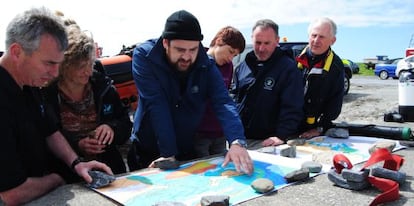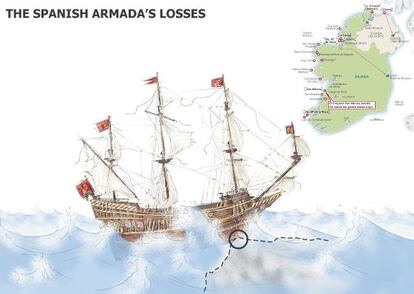Piecing together the Spanish Armada’s sunken remains off the Irish coast
Archeologists are closer than ever to identifying where the pride of Philip II’s fleet went down in 1588

The Invincible Armada had been navigating its way through the wilderness of the North Atlantic. On the dawn of September 7, 1588, the Duke of Medina Sidonia, captain of the San Martín and the commanding officer of the vast fleet Philip II had created to invade England, scanned the horizon. Low on water and provisions, he now faced the task of returning to Spain with 112 badly damaged vessels carrying around 3,000 wounded by sailing round Scotland, and then the west coast of Ireland.
The situation was bad, but what the duke didn’t know was that things would soon get a lot worse. “The human and naval disaster inflicted on the Great Armada didn’t take place in the English Channel as a result of English cannons, but happened on the west coast of Ireland,” says Hiram Morgan, a researcher at the University of Cork. “This forgotten corner was where 24 ships were wrecked and 6,000 men drowned.”
More than four centuries on, the Spanish Armada continues to fascinate the Irish. The west coast is littered with towns and villages linked to the fate of some Spanish vessel or its crew. Archeologists first began finding relics from six of the 24 vessels that sank off Ireland’s west coast in 1967, placing them on display in museums in Derry, Belfast and Dublin.

The most recent campaign kicked off in May, and is about to come to an end. Its objective has been to locate the San Marcos, a galleon that went down close to Spanish Point, in County Clare. Built in 1585 in Cantabria, the San Marcos was one of the jewels in the crown of the Armada. Weighing 790 tons, it had more than 60 guns, and carried 350 soldiers and 140 sailors.
John Treacy, the director of the San Marcos Project, and a history lecturer at Mary Immaculate College in Limerick, is pleased with the progress made in finding the vessel. In June, after exploring a three-kilometer area on the seabed, his team’s sonar detected a large anchor. “The design is the same as anchors used on Spanish vessels in the 16th century,” he says. “But we need to get confirmation from the Department of Arts & Heritage’s submarine archeology unit. The aim would then be to find one of the 33 bronze cannons she carried. We are about to find the Armada’s very own Titanic,” he says.
The opulence of the ‘Girona’

On the night of October 28, 1588, the Girona was trying to make its way to the southwest coast of Scotland. The vessel was captained by Alonso Martínez de Leiva, second-in-command of the Spanish fleet. Aboard were some of Spain's most important nobles. "There were about 1,300 men aboard, many of them survivors of two other vessels that had sunk," says Tom Timoney, a member of Templemore Archeology, a Derry-based association dedicated to researching the Armada.
One of the survivors of the wreck provided the origin of the surname Morning, which is common in Derry. “The morning after the sinking, local people found a man wandering on the beach. He was naked, disoriented, and spoke neither English nor Gaelic, and so they called him Adam Morning, in honor of the first man, and because they found him in the morning,” says Fionnbarra Ó Dochartaigh, another member of the association.
The Girona has fascinated underwater archeologist Robert Sténuit since he was a child. In the mid 1960s he began searching for its remains in Port na Spaniagh and Lacada Point, two of the loveliest spots near the Giant's Causeway, until, in 1967, he came across a lead ingot stamped with the five crosses of Jerusalem; he later found gold and silver buttons, along with jewelry, medals, and canons.
Guiding visitors round the special room dedicated to the Girona in Belfast's Ulster Museum, curator Winifred Glover highlights the importance of the finds on show there. "The men that were aboard the ship were all members of the aristocracy, as well as adventurers and soldiers, people who dressed opulently," she says, pausing before a gold salamander encrusted with rubies of Aztec origin. "The Girona was the last ship of the Armada to sink off Ireland, and it's a metaphor for a powerful and proud empire that literally sank off one of the most beautiful spots in Ireland, creating a legend in the process," says Glover.
A few days away from the end of the campaign, Treacy and his team of local divers assess the outcome. “The results are very encouraging, particularly after having found a space on the seabed that fits with the sinking of a large vessel,” says Treacy. “This has allowed us to set a series of objectives to be analyzed by the divers, the results of which will be shared with Arts & Heritage for their evaluation.” This will be a long and laborious process, given that 21 other vessels from different periods have also gone down in the same area over the centuries.
Treacy says the project would not have gotten off the ground without the help of local communities. “Apart from the Irish government’s technology to help map the sea bed, this initiative got going with a budget of €2,000 and the collaboration of Spanish Point and other towns in the area,” says the director. “The divers have worked hard in difficult conditions free of charge, just like the historians and the researchers. A local philanthropist has donated a boat.”
The San Marcos sank on the afternoon of September 20, 1588 after hitting rocks close to Mutton Island. “The impact must have been terrible in the midst of the storm,” says Treacy, pointing out that just four men out of 490 made it to shore. The same day, another ship, the San Esteban, suffered the same fate a few kilometers down the coast, with the loss of 300 lives. The 60 men that survived, along with the four survivors from the San Marcos, were captured by Boetius Clancy, a local landowner who represented the English colonizers. His orders were to interrogate and then execute all Spanish prisoners, regardless of rank, among them Felipe de Córdoba, a nobleman who would have fetched a large ransom. He and the others were all hanged on a high point overlooking the beach at Spanish Point.
Nearby is the mass grave where they were buried, along with the bodies washed ashore from the two vessels, known to this day as Tuama na Spáinneach (the Spaniards’ tomb).
Judith Ironside, a local historian now in her eighties, says that local people still respect the mound, which is topped by three large white stones and covered in flowers in summer. “I take my dogs for a walk nearby every morning, but I never let them play there,” she says. Michael J. Haran, the farmer who owns the land the grave lies on, says he was never allowed to play there as a child: “My great grandmother forbade us from playing there, saying that it was where the Spanish were buried.”
Many Irish people still believe that survivors of the Armada settled in Ireland. “That explains why you have people like me; with black hair, brown eyes, and olive skin: we’re the descendents of the Armada, the so-called black Irish,” says Eddie McGorman, organizer of the Celtic Fringe Festival, as he looks out over Streedagh Strand beach, where La Lavia went down. It was captained by Francisco de Cuéllar, who later wrote of the eight months he spent hiding out in Ireland.
“It’s a lovely story, but sadly, it’s just another Irish myth,” says the University of Cork’s Hiram Morgan, “I’m sure that men like Cuéllar and other Spanish soldiers got to know local women, but to make the leap that a handful of Spaniards were the ancestors of all dark-skinned Irish people is probably overstating things,” he says.
The ‘Trinidad Valencera’ mandolin

“It’s little more than a footnote in the history books, but the Illagh massacre was one of the cruelest episodes endured by the survivors of the Invincible Armada,” says Marcas Ó Murchú, musician and amateur historian, as he wanders through the ruins of Illagh Castle, in the outskirts of Derry on the north coast of Northern Ireland.
"This was the final port of call for 400 soldiers and sailors from La Trinidad Valencera, commanded by Alonso de Luzón, which had the dubious honor of being the first ship from the Armada to sink off the Irish coast, on September 16," says Murchú. Luzón led his men to the site believing that they would be given help. But after surrendering and laying down their arms, and having been separated from their senior officers, 300 unarmed men were speared to death and shot with arquebuses by the English garrison stationed there.
The Trinidad went down in Kinnagoe Bay, north of the Inishowen peninsula, where it lay for 383 years until divers from the Derry Sub-Aqua Club found it by accident in 1971. Today, relics from the wreck can be seen in Derry's Tower Museum. "There are all sorts of things, among them cannons, but the most valuable items are the everyday objects, such as the remains of a mandolin neck," says Terence O'Kane, the museum's director.
Tu suscripción se está usando en otro dispositivo
¿Quieres añadir otro usuario a tu suscripción?
Si continúas leyendo en este dispositivo, no se podrá leer en el otro.
FlechaTu suscripción se está usando en otro dispositivo y solo puedes acceder a EL PAÍS desde un dispositivo a la vez.
Si quieres compartir tu cuenta, cambia tu suscripción a la modalidad Premium, así podrás añadir otro usuario. Cada uno accederá con su propia cuenta de email, lo que os permitirá personalizar vuestra experiencia en EL PAÍS.
En el caso de no saber quién está usando tu cuenta, te recomendamos cambiar tu contraseña aquí.
Si decides continuar compartiendo tu cuenta, este mensaje se mostrará en tu dispositivo y en el de la otra persona que está usando tu cuenta de forma indefinida, afectando a tu experiencia de lectura. Puedes consultar aquí los términos y condiciones de la suscripción digital.








































